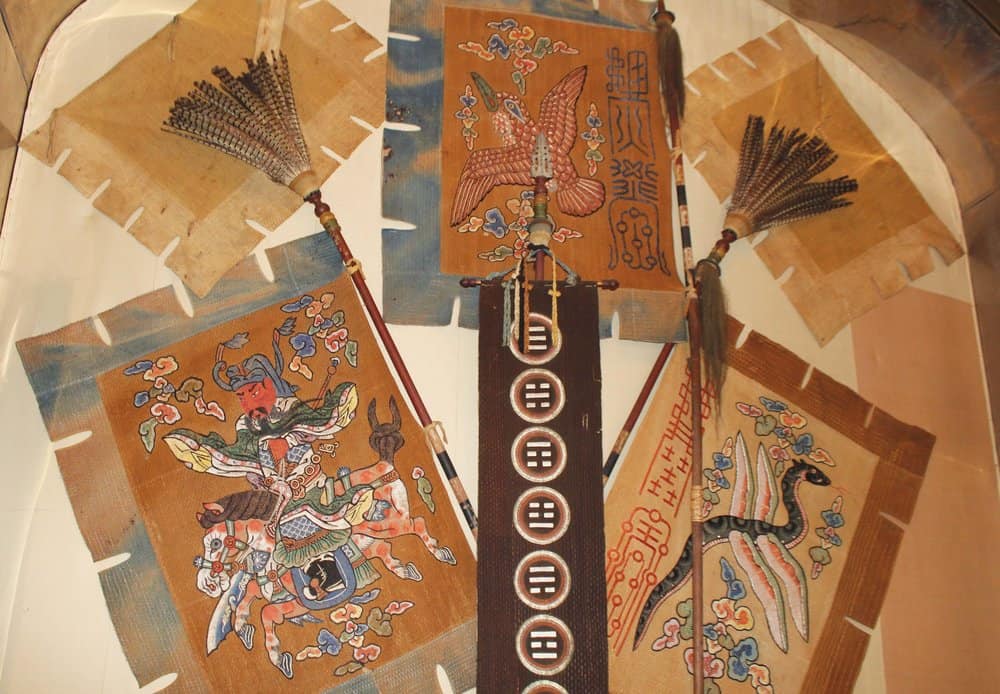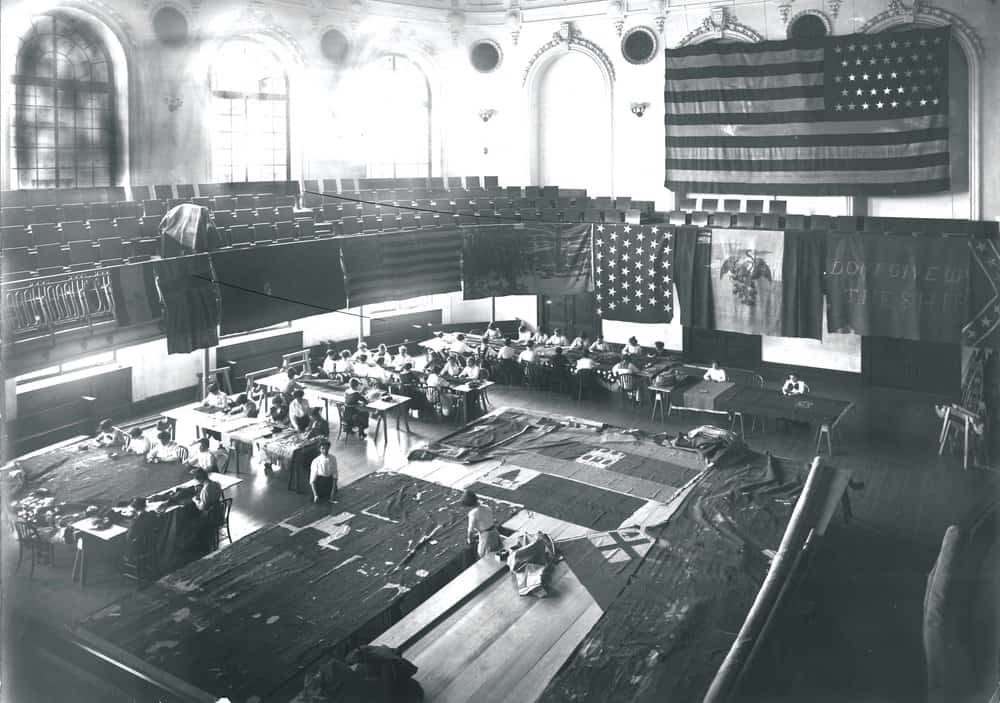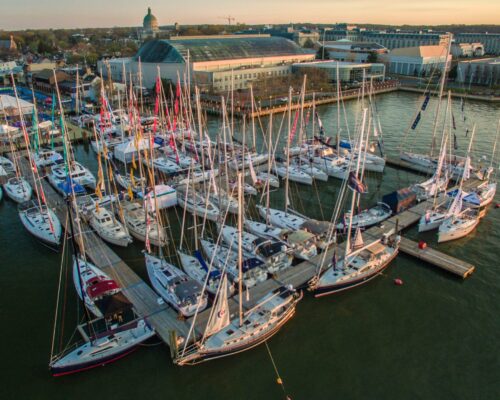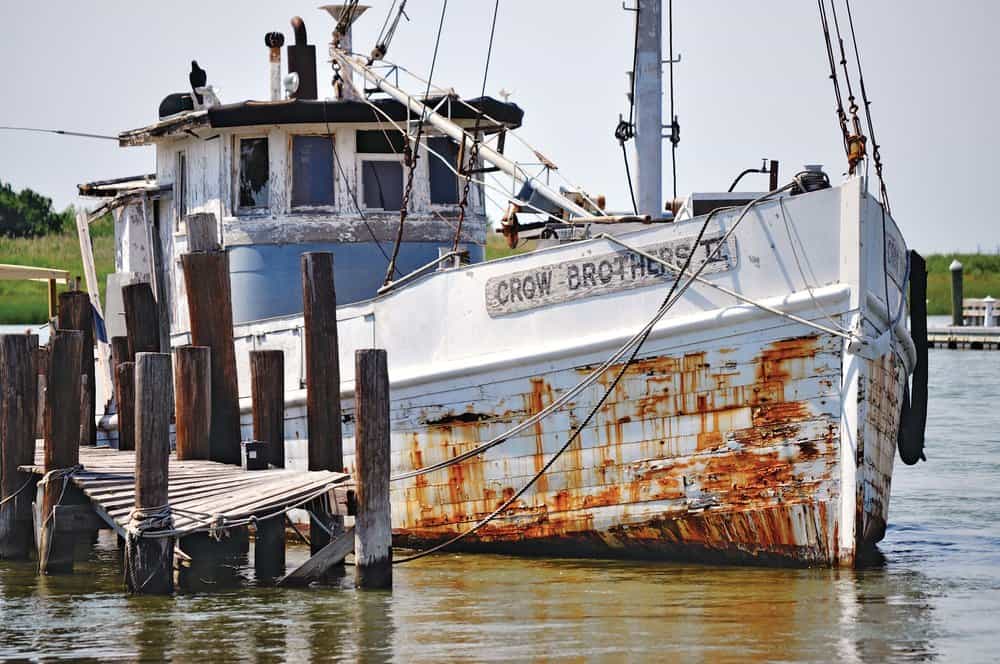“They just need a rest,” said United States Naval Academy Museum Managing Director and curator Charles Swift, considering the faded flags displayed around the Yard.
After more than 100 years on display, the Academy’s United States Navy Trophy Flag Collection deserved a respite so the flags could be stored and conserved. As some of the flags were removed from their casings last year, Swift and his crew were thrilled by what they found hiding underneath—an assortment of flags, concealed for a century-plus. This new cache of captured cloth, fibers faded and edges tattered, join the museum’s world-class collection of trophies that tell the maritime stories of America’s sailors, stitch by stitch.
In 1849, President James K. Polk declared that the Naval Academy would officially become the repository for the Navy’s collection of flags captured in battle. Over 60 years later, many of the flags were deteriorating and, in 1912, Congress authorized their preservation. Amelia Fowler, a renowned flag preservationist who would go on to restore the original Star Spangled Banner, was hired for the task. In 1913, using a special stitch of her own creation, she began work on dozens of flags in Mahan Hall’s auditorium. Over the course of a year, Fowler and her team painstakingly worked to restore more than 170 flags. To a modern-day museum visitor, the conserved ensigns and banners may look a bit rough. But Swift explains that, thanks to Fowler and her team, they are likely in the same weathered but stable condition as when they preserved them, more than 100 years ago.

The collection of 250 to 300 flags spans conflicts from the Revolutionary War through Vietnam. From Italian to Korean, Japanese to Hungarian, the flags’ nationalities are diverse, but Swift says the majority are products of the Spanish-American War and the War of 1812. The large concentration of 1812 flags, Swift explains, conveys the newly-formed United States’ ability to take on the British as a worthy adversary. The War of 1812 “established the ability of the American Navy to go toe to toe with the British, and the flags that we were able to capture reflect that ability.”
Yet, not all flags in the Naval Academy’s collection were captured. The most famous is the iconic “DONT GIVE UP THE SHIP” flag (that’s right, no apostrophe), which is a memorial created to commemorate the last words of Captain James Lawrence who was critically wounded in battle aboard the U.S.S. Chesapeake during the War of 1812. Oliver Hazard Perry, his fellow naval officer and friend, commissioned a flag inscribed with his comrade’s dying plea. Perry flew it during the Battle of Lake Erie and ultimately to victory.
In the early days of battle, Swift says rules for capturing trophies or other articles of war were essentially non-existent. All was fair, as they say, in love and war. However, Swift explains, “the rules of acquiring battle trophies have changed since the Vietnam War. It’s been increasingly difficult to take things like this, because they don’t want military personnel risking their lives to capture the flag. As the nature of war has changed, the artifacts and things that you might normally expect to be able to acquire, they’ve changed.”
Swift says they’ve returned a number of flags to the countries of origin. Flags were sent back to Mexico for the 10th anniversary of the Mexican-American War, and another was returned to South Korea on long-term loan.

Swift and his team knew there was a possibility that other flags were hiding behind their displayed counterparts. “When we started this flag conservation project, we planned to open five cases with historic Navy trophy flags in them. We knew, from looking through the glass, that there were 15 flags at least. Our records indicated that there could be up to 61 flags,” he says. When the glass was cut, an assortment of 46 flags was discovered. In addition to flags from Korea and the Spanish-American War, four replica American Revolution flags and other various trophy flags came out of the shadows. One sizeable flag from the War of 1812 measured in at 14 by 24 feet. Swift says some are the right size for framing and display, so visitors may soon be able to lay eyes on the new additions. And it should be quite the sight; “the fact that these hadn’t been exposed to light for 100 years means that they are in very good condition,” Swift explains.
The newly discovered, vibrant flags will join the larger collection to tell the epic story of battles at sea, preserving the memory and legacy of those who fought under them for freedom.
Laura Boycourt is a freelance writer, mom to two little pirates, and lifelong boater from Annapolis who’s perpetually in need of a large coffee and a salty breeze.




